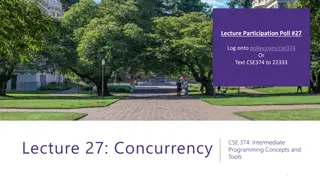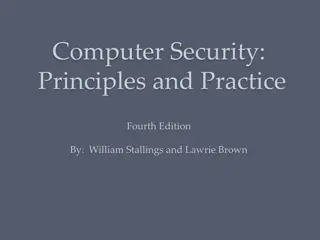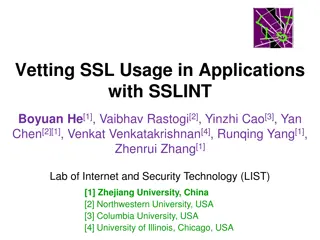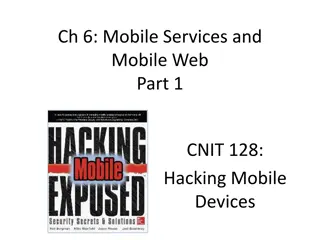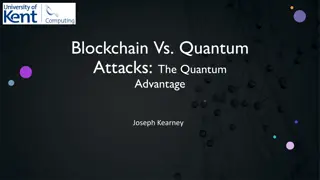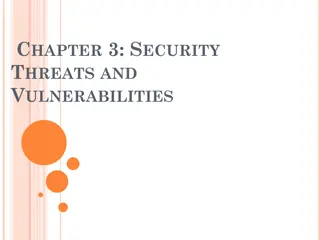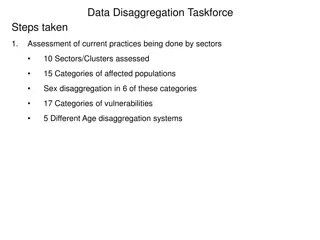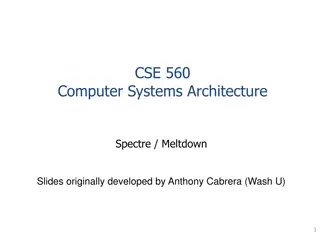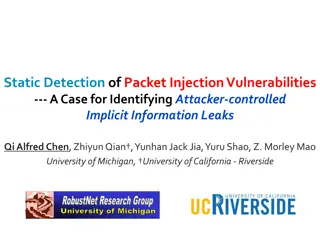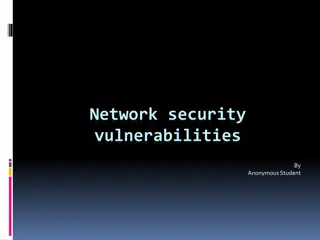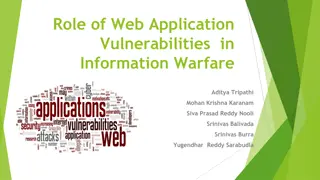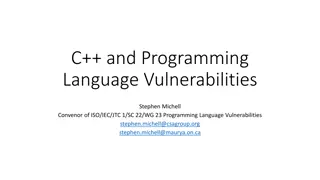Analysis of McEliece Vulnerabilities in Escher's World
In this detailed study by Ray Perlner and Dustin Moody from NIST, the vulnerabilities of McEliece in Escher's world are explored. The research covers error sets, commonalities with other variants, private key operations, decoding algorithms, encryption, and more. The findings shed light on potential threats, signature forgery, key recovery, and countermeasures for enhancing security.
Download Presentation

Please find below an Image/Link to download the presentation.
The content on the website is provided AS IS for your information and personal use only. It may not be sold, licensed, or shared on other websites without obtaining consent from the author.If you encounter any issues during the download, it is possible that the publisher has removed the file from their server.
You are allowed to download the files provided on this website for personal or commercial use, subject to the condition that they are used lawfully. All files are the property of their respective owners.
The content on the website is provided AS IS for your information and personal use only. It may not be sold, licensed, or shared on other websites without obtaining consent from the author.
E N D
Presentation Transcript
Vulnerabilities of McEliece in the World of Escher Ray Perlner, Dustin Moody National Institute of Standards and Technology Gaithersburg, Maryland, USA Ray.Perlner@NIST.gov; Dustin.Moody@NIST.gov
Outline McEliece in the World of Escher [Gligoroski, Samardjiska, Jacobsen, Bezzateev 2014] A McEliece variant promising encryption and signatures New ideas: Error sets List decoding Encryption and signature schemes: Private key Decoding algorithm Major Results ISD for the error vector (signature forgery) ISD for the private key (key recovery for both encryption and signature) Countermeasures?
Commonalities with other McEliece Variants. Private key operation is a decoding problem Generator Matrix form: ?????+ ? = ? Parity Check Matrix form: ????(? ?)?= 0 ?????+ ? = ?(?) ????(?(?) ?)?= 0 Public Generator/Parity Check matrix is disguised Private Generator/Parity Check matrix ????= ??? ????= ? ??
Escher McEliece Error Sets Standard Code-based crypto Error vector is a biased sample from the 1-bit alphabet (0,1) E.g. (00|10|11|00|00|10|00|01) Mean: 0.33 44% 00; 22% 01; 22% 10; 11% 11 Error sets Error set is an unbiased sample from a limited l-bit alphabet. E.g. (00,01,10) E.g. (01|00|00|01|00|10|01|01) Mean: 0.33 33% 00; 33% 01; 33% 10; 0% 11
Error Set Density, ? For an error set of block size l bits, Gligoroski et al define the density as: ? = ? = |? | For example for the error set (00,01,10) ? = 3 1 12
Escher McEliece The Private key
Escher McEliece Decoding Encryption Divide Message as ?1?2 |??, where ??has length ?? Divide Ciphertext as ?0?1?2| |??, where ?0has length ? and the other ??have length ?? Divide ?0as ?0[1] ?02 |?0[?], where ?0[?] has length ?? Step 0: Compile a list of all the possible decodings of the first ?1bits of ? ?1= ?01 + ?0[1] Step 1 ? ?: Update by checking consistency and (if necessary) extending the decoding. (?1| |??) ??+ ??= ?? ??+1= ?0? + 1 + ?0[? + 1] Note the complexity of decoding is set by the list size at step 1: ??1, so ?1can t be too big.
Escher McEliece Decoding Signatures Divide Message as ?1?2 |??, where ??has length ?? Divide Ciphertext as ?0?1?2| |??, where ?0has length ? and the other ??have length ?? Divide ?0as ?0[1] ?02 |?0[?], where ?0[?] has length ?? Step 0: Compile a list of some of the possible decodings of the first ?1bits of ? ?1= ?01 + ?0[1] Step 1 ? ?: Update by checking consistency and (if necessary) extending the decoding. (?1| |??) ??+ ??= ?? ??+1= ?0? + 1 + ?0[? + 1] ??to survive consistency 2 ? Note the complexity of decoding is set by the list size at step w. Needs to be at least checks. Thus ??can t be too big.
Information set Decoding for Errors 1. Permute the columns of ???? ? ???= ????? = ? ? 2. Check that A is invertible 3. Guess the first ? bits, ?, of the permuted error vector ??. If so: ?? = ? ? ? + ?? = ?|? = ?? + ? ? ? ? ? 1= ? 4. Check the guess by computing the weight/pattern of: ? ? ? ? 1???? If the guess fails, repeat.
Using ISD for Errors to Forge Signatures The efficiency of ISD depends on the probability of guessing ? bits of the error vector of a valid signature Note that there is not a unique valid signature for each message. For the error set (00, 01, 10) We can guess a single bit (0), and the other bit is guaranteed to be valid. By choosing the permutation such that all ? information-set bits come from different blocks, we guarantee that 2? of the ? bits form a valid error vector. The probability the remaining ? 2? bits are also in the error set is: ? 2? 3 ? = . 2 Examples: Code (650,306): Claimed security 287.54; ? = 2 7.88 Code (1578,786): Claimed security 2137.11; ? = 2 1.25
Can this forgery be avoided? This attack can be avoided by Only accepting signature error vectors with hamming weight ~?/3. ? 1.5? 3 This only gets ? = not enough. 2 Increasing the ratio ? ? But this will enable/worsen other attacks. More later
Information Set Decoding for the Private Key. Information set decoding algorithms find low weight vectors in the row space of a matrix Can be applied to ????or ????. Note that ????and ????have the same row spaces as ? and ? up to a Permutation. ??. ?? = ??. ??? = ?? ?? 1??? = ??( ?? 1????) ??. ?? = ??. ??? = ?? ?? 1? ?? = ??( ?? 1????) 13
Where are the low-weight targets? This has to be small for signature This has to be small for encryption
Once we have low weight vectors, then what? The nonzero bits of low weight vectors all come from the same columns in the private matrix Encryption ?: Columns 0, , ?1 1;?, , ? + ?1 Signature ?: Columns 0, , ?1 1;? ??, ,? 1 The nonzero bits of the low weight vectors will therefore come from the images of these columns under ? So, we can simply find these columns and lop them off. The result is a smaller matrix of the same form we started with. Repeating the process is generally easier.
Detecting the Structure through Statistics. ?? ? ? =
Generic information set decoding 1. Permute the columns of ???? ? ???= ????? = ? ? 2. Check that ? is invertible 3. Left multiply by ? 1. ? = ? 1? ???= (?|?) 4. Check for low weight ? in rowspace of ? Check weight of ? = ??. If low, return ? = ??? 1. 18
Why does this work? H = HPP , H pub, M all have the same rowspace vM is the unique element of that rowspace with prefix v v is a guess for the first n-k bits (IS) of hPP h is a low weight element of the rowspace of H Best guess: (almost) all zeroes All zeroes won t work, since 0M = 0 19
Optimization 1 Using a nonrandom ? The permutation ? used to disguise ? is non-random. It needs to keep l-bit blocks of columns intact. The permutation ? used for ISD should be non-random in the same way. Note that if one column in a block is in the set we want to remove, the rest are too.
Optimization 2: Using rank to check if we re removing the right columns Low weight vectors don t all come from the correct rows: Vs. But, we can tell which is which pretty quickly. Removing most of the highlighted columns at left will reduce the rank. Removing the same number of columns highlighted on the right won t. And we can find the rest of the columns pretty easily too. Just check if removing a column reduces the rank more.
Key Recovery Results We implemented the key recovery attack in SAGE on a laptop. We applied it to the 80 bit parameters for signature and encryption. Block structure was correctly recovered in less than 2 hours in both cases.
Can the scheme be saved? Encryption: Change the error set: counterproductive Key recovery can be avoided by increasing ? However, the keys get ~300 times bigger to achieve claimed security. Signature: Change the error set: still counterproductive Key recovery can be avoided by increasing But this worsens the previously discussed forgery attack. Doesn t look like signature can be saved. ? ? ? ?
Conclusions We demonstrated two highly efficient attacks Near trivial signature forgery. Practical key recovery for both signature and encryption. It is possible the encryption scheme can be saved Although at the cost of making an inefficient scheme several orders of magnitude worse. Attack is only quasi-polynomially costlier than decryption. The signature scheme does not appear fixable




